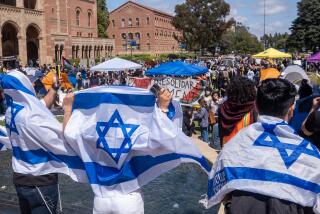Opinion: Is California’s draft ethnic studies curriculum anti-Semitic?

- Share via
The number of hate crimes against Jews in California increased more than those against any other group in 2018, according to the state Attorney General’s Office. That, of course, doesn’t include the gunman’s attack on a synagogue in Poway on the last day of Passover this last April. In fact, the only group that experienced more hate crimes last year were Latinos, whose population in the state is much higher. The number of hate crimes against Muslims was less than half that of those against Jews. The numbers of hate crimes and other incidents targeting Jews have been rising dramatically at the national level as well.
But don’t expect to find this or similar information about anti-Semitism in the draft of a “model curriculum” for teaching ethnic studies in public high schools in California. There’s a long list of the kinds of hatred that have oppressed minority groups in California, including bigotry against Muslims and transgender people. All of the items on the list belong there, but anti-Semitism is curiously missing.
It could be seen as an oversight if there weren’t other, distinct signs of anti-Jewish bias in this curriculum meant to address issues of ethnic history, misunderstanding and prejudice. In fact, the signs are so apparent that Assemblyman Jose Medina, D-Riverside, author of a bill to mandate an ethnic studies course in California high schools, has joined with other legislators in signing a letter that shreds the curriculum.
You have a chance to do something about the proposed curriculum too. The public can comment on the draft until Aug. 15 (instructions below). In any case, you have to read this thing to believe it. The document meant to serve as guidance for an ethnic studies course is right now probably the biggest threat to Medina’s bill.
That would be a shame. An ethnic studies course is an appropriate response to the many years in which history has been taught as the story of successful white people, all but ignoring rich cultures and deep histories with differing origins. We also can’t ignore the need for greater awareness and mutual respect during a time of animus against so many marginalized people — and a period in which people who are filled with prejudice feel entitled to act, sometimes violently, on their hatred and rage.
But in too many places, this curriculum seems designed to proselytize a specific set of beliefs (far beyond the basic “stereotyping and racism are bad”) rather than expand understanding among groups. In fact, it’s one of the most problematic things to have come out of Sacramento on education, and that’s saying something.
In an editorial Sunday, The Times editorial board argued that the ethnic studies draft, created by a committee of teachers and academics, was rife with dense, politically correct and sometimes fairly incomprehensible wording, as well as implied judgments about what students should think.
Many times, and in many ways, this curriculum makes a mockery of the very good an ethnic studies course should attempt to bring about, with its efforts to inculcate an agenda rather than encourage diversity of opinion. It blatantly equates capitalism with white supremacy and racism, as a tool of oppression, and while there is almost certainly some truth to that, it never allows for the possibility that capitalism might have made positive contributions as well. The social movements it suggests studying come from only one shade of the political spectrum. If nothing else, its biases are clear in the jargon it uses, words such as cisheteropatriarchy, anthropocentrism and hxrstory.
But it was the built-in bias against Jews and Israel that led the California Legislative Jewish Caucus to send a letter excoriating the curriculum. Medina, a member of the caucus, signed on.
The letter points out that the curriculum encourages students to study the Boycott, Divest and Sanction movement as one of various worthy “social movements.” It defines BDS as “a global social movement that currently aims to establish freedom for Palestinians living under apartheid conditions. Inspired by tactics employed during the South African anti-apartheid movement, the Palestinian-led movement calls for the boycott, divestment, and sanctioning of the Israeli government until it complies with International law.” Nowhere does it acknowledge that this is a controversial movement with many opponents, or that it also would cut off Israeli scholars; it is written as though there is one truth and one truth only for students to learn about this.
It’s also remarkable that Israel is singled out in this way. What about nations that deprive women of basic rights and religious groups of the right to practice their beliefs? If this is a course about international rights controversies, it is woefully noninclusive.
The caucus letter goes on to outline ethnic stereotyping in the curriculum, asserting: “In the few instances where the [curriculum] actually acknowledges Jews, it does so in a denigrating and discriminatory manner.” The draft recommends that teachers quote lyrics by British Palestinian recording artist Shadia Mansour asserting that “Israelis ‘use the press so they can manufacture,’ a classic anti-Semitic trope about Jewish control of the media.” In other words, saying this is about Israel, not about Jews, doesn’t pass scrutiny when language long used to foment anti-Semitism is recommended. For that matter, even if it were only about Israel, it would be wrong for a public school curriculum to take one side or the other in a complex and deeply controversial international dilemma.
It’s hard to imagine that a few edits could fix what’s wrong with this supposed model for teaching understanding and critical thinking. As a mother of kids who went through the public school system (and who would have refused to place them in a course that made them feel attacked for their minority identity), as a journalist who considers it crucial to listen to and consider all sides of a debate and allow people to voice their views without fear of retribution, and as a Jewish resident of California, this makes me question the competence, objectivity and intent of the committee that drew up the curriculum.
Speaking of the spectrum of opinion, you can send your opinion of the draft curriculum to the state before it is considered by the State Board of Education and schools Supt. Tony Thurmond. There’s a template at the bottom of the page on this link to the curriculum; filled out as a Word document, it can be sent to [email protected]. Or if you can’t create a Word document, just send a letter, as the legislators did. Your opinion might be quite different from mine, which is what ethnic studies should be all about: reading, informing ourselves, debating, learning about the diversity of viewpoints, and freely expressing our own.
More to Read
A cure for the common opinion
Get thought-provoking perspectives with our weekly newsletter.
You may occasionally receive promotional content from the Los Angeles Times.











